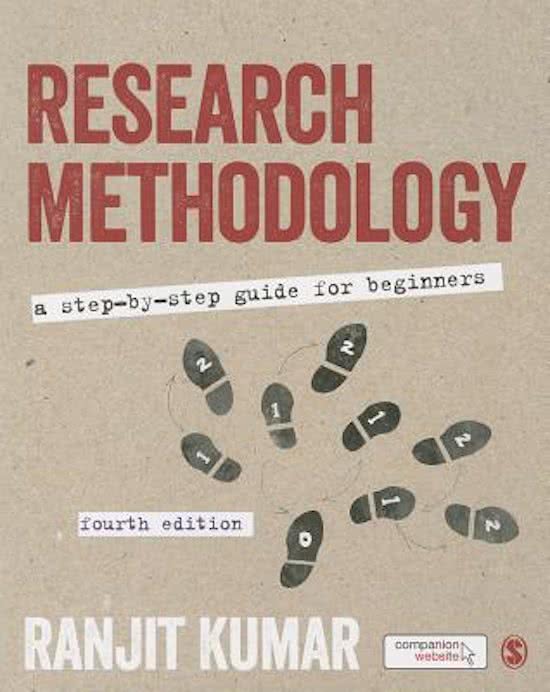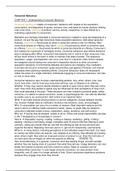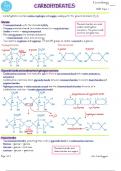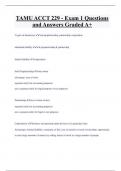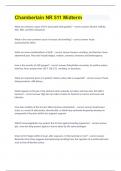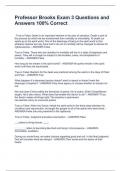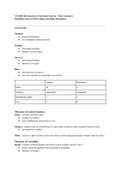CHAPTER 1: Research: A Way of Thinking
What is research?
Research is a structured process to gather evidence
Research is (mostly) conducted based on theoretcal frameoork
Research uses methods & techniques tested for validity and reliability
Research ideally is unbiased & objectve
Research = one of the ways of fndings answers to your professional and practce questons. It is characterized
by the use of tested procedures and method and an unbiased and objectie attude in the process of
exploraton
Research is a oay of thinking:
It deielops in you a way of thinking that is logical and ratonal (analytcal oay of thinking)
It encourages you to critcally examine every aspect of your day-to-day situaton
It helps you to understand and formulate guiding principles that goiern a partcular procedure in
your practce
It helps you develop and test neo oays that contribute to the adiancement of your practce and
profession
The knooledge of research methodology proiides you with the techniques to fnd answers to your
research questons
Research is an integral part of your professional practce:
Among many professions, research and practce are well integrated
Practce relies iery heaiily upon what is discoiered through research (cannot be separated)
The greater the integraton between research and practce, the greater the advancement in its
theoretcal and practce knowledge base
Research is a habit of questoning ohat you do
It is a systematc oay of examining your clinical obseriatons to explain and fnd answers for what you
obserie in your practce
You haie a vieo to insttutng appropriate changes for a more effectve professional seriice
For eiery profession, there can be asked different types of questons relatng to efectieness and
efficiency of a seriice (Health: How efectie is the seriice Business: How satsfed are consumers )
Consumers haie the right to ask questons about the quality and efectieness of the seriice; the
seriice proiider has an obligaton to answer their questons
As a service provider, you should be able to answer them objectiely, which is why you should do
research
Research is a oay to gather evidence for your practce
It is a oay of collectng accurate, sound and reliable informaton about the effectveness of your
interientons, thereby proiiding you with eiidence of its efectieness
Evidence-based practce (EBP) = a seriice deliiery system that is based upon research eiidence as to
its effectveness; the seriice proiider’s clinical judgement as to the suitability and appropriateness of
the seriice for the client; and the client’s own preference as to its acceptance (origin in medicine)
It’s now promoted as an acceptable & scientic method for policy formulaton & practce assessment
It encourages professionals and other decision-makers to use evidence; as a professional you must
be accountable to your clients as well as your profession
As seriice proiiders and professionals, we use techniques and procedures (research) to consolidate,
improve, develop, reine, and advance clinical aspects of our practce to serie our clients beter
Applicatons of research in practce development and policy formaton
The use of research skills is mostly applied = they are ofen used in the deielopment of practce skills and
procedures, and the formulaton of practce policies
, All professions use the methods and procedures deieloped by research methodologists in order to
increase understanding of diferent aspects of practce in their own profession and to enhance their
professional knowledge base (strengthen and adiance knowledge and skills)
The applicaton of research can be vieoed from four different perspectves:
1. The Service Provider
To answer questons such as: How many people are using the service/product? Why do some people
use the service and others don’t? How efeccve is the service/product? How can it be improved?
2. The Service Administrator, Manager and/or Planner
To answer questons such as: What are the needs of the community? What types of services/products
are needed? How many service providers are needed? How many cases can a worker handle in a day?
3. The Service Consumer
To answer questons such as: Am I, as a consumer, getng value for money? How good are the service
providers? What are the long-term efect of the product I am using? Where is the evidence?
4. The Professional
To answer questons such as: Which is the most efeccve intervencon for a parccular problem? What
is the relaconship between X and Y? What is the best way of measuring attudes? How valid is a
parccular theory in the present condicons?
You should be able to use this to idencfy the possible issues in your own academic feld
Research = the process of expanding the existng stock of knooledge about a speciic subject with neo
insights
These 3 criteria enable the process to be called ‘research’; the process being applied:
Is being undertaken oithin a frameoork of a set of philosophies
Philosophical orientaton = may stem from one of the seieral paradigms and approaches in research;
interpretie, feminist, qualitatie, mixed methods, and the academic discipline in which you haie been trained
Uses procedures, methods, and techniques that have been tested for their validity and reliability
Validity = ensures that in a research study, correct procedures haie been applied to fnd answers to a queston
Reliability = refers to the quality of a measurement procedure that proiides repeatability and accuracy
Is designed to be unbiased and objectve
This means you haie taken each step in an unbiased manner and drawn each conclusion to the best of your
ability and without introducing your own iested interest
Subjectvity = an integral part of your oay of thinking that is ‘conditoned’ by your educatonal background,
academic discipline, philosophy, experience, and skills
Bias = a deliberate atempt to either conceal or highlight something that you found in your research that is in
reality not there but you do it because of your iested interest or to use deliberately a procedure or method
that you know is not appropriate but will proiide informaton that you are looking for because you haie a
iested interest in it
When you succeed to fulfll those three criteria, it is enabled to be called ‘research’. However, the degree to
which these criteria are expected to be fulflled varies from discipline to discipline;
Physical sciences = a research is expected to be strictly controlled at each step
Social sciences = control cannot be enforced
The diference between research and non-research actiity is in the way we fnd answers to our research
questons (not all research is based upon complex technological methodologies and use statstcs)
Research = a process for collectng, analyzing and interpretng informaton to answer research questons
To qualify to be called ‘research’, characteristcs and requirements are that the research process must be:
Controlled = in exploring causality in relaton to two iariables, you design a study in such a way that
enables you to control/quantfy the efects of all other iariables on the dependent iariable so that
the efect of the independent iariable can accurately be assessed
Rigorous = you must be scrupulous in ensuring that the procedures followed to fnd answers to
questons are releiant, appropriate, and justfed
, Systematc = the procedures adopted to undertake an iniestgaton follow a certain logical sequence
Valid and veriiable = whateier you conclude on the basis of your fndings in correct and can be
ierifed by you and others
Empirical = any conclusions drawn are based upon hard eiidence father from informaton collected
from real-life experiences or obseriatons
Critcal = critcal scrutny of the procedures used and the methods employed is crucial to a research
enquiry. The process of iniestgaton -> foolproof & free from any drawbacks, withstand critc scrutny
Three perspectves that form the base of the classiicaton of research:
o Applicatons of the fndings of the research study
o Objecties of the study
o Mode of enquiry used in conductng the study
Mode of enquiry = classifes the research types on the basis of the diferent philosophies that guide them
Applicaton and objectves = look at the research classifcaton from the uses and purposes point of iiew
Not mutually exclusive = a research study classifed from the iiewpoint ‘applicaton’ can also be classifed
from the iiewpoint of ‘objecties’ and ‘enquiry mode’ (project can be applied, explanatory, quanttatie)
APPLICATION PERSPECTIVE
Too broad categories:
Pure research = concerned with the deielopment, examinaton, ierifcaton, and refnement of
research methods, procedures, and techniques that form the body of research methodology
(involves developing and tescng theories and hypotheses that are intellectually challenging to the
researcher but may or may not have pracccal applicacon at the present cme or in the future (Bailey))
Applied research (most) = the research techniques, procedures, and methods that form the body of
research methodology are applied to the collecton of informaton about iarious aspects of a
situaton, issue, problem or phenomenon so that the informaton gathered can be used in other ways
(policy formulaton, programme deielopment, programme modifcaton, eialuaton, etc.)
The purpose of applied research:
- Collectng data on practcal issues
- Analysis of data to understand the situaton
- Proiide adiice to solve problems and/or improving situatons
- Solving pracccal problems through advice based on empirical research
- Understanding target audiences (preferences & behaiiors)
- Identfcaton of trends
- Improiement of communicaton processes
- Designing communicaton products & strategies
OBJECTIVES PERSPECTIVE
A research from this perspectve can be classiied as descriptve, correlatonal, explanatory or exploratory;
Descriptve study = atempts to describe systematcally a situaton, or proiides informaton about the
liiing conditons of a community, or describes attudes towards an issue. The main focus is on
descripton, rather than examining relatonships or associatons. The main purpose is to describe what
is preialent with respect to the issue or problem under study
Correlatonal study = studies which are primarily designed to iniestgate whether or not there is a
relatonship between two or more iariables (ascertain if there is a relatonship)
Explanatory research = studies that atempt to clarify why and how there is a relatonship between
two aspects of a situaton or phenomenon (why the relatonship is formed)
Exploratory research = when a study is undertaken with the objectie either of exploring an area
where litle is known or of iniestgatng the possibilites of undertaking a partcular research study.
Also conducted to deielop, refne and/or test measurement tools and procedures
A good study combines all frst three objecties (descriptie, correlatonal, explanatory), therefore, most
studies are a combinaton of those three
Feasibility study/Pilot study = when the purpose of a study is to iniestgate the possibility of undertaking it on
a larger scale and to streamlining methods and procedures for the main study (in an exploratory research)
Small-scale study = undertaken to decide if it is worth carrying out a detailed iniestgaton
, MODE OF ENQUIRY PERSPECTIVE
Three approaches that are used in social research to fnd answers to your research questons: the quanttatve
approach, the qualitatve approach, and the mixed methods approach
The core diference between the three is the extent of fexibility permited to you as a researcher in the
research process (last diference in the table)
Quanttatve/structured approach Qualitatve/unstructured approach
Follows a rigid, structured, and predetermined set of Follows an open, fexible and unstructured approach to
procedures to explore enquiry
Aims to quantfy the extent of iariaton in a phenomenon Aims to explore diversity rather than to quantfy
Emphasizes the measurement of variables and the objectvity Emphasizes the descripton and narraton of feelings,
of the process perceptons, and experiences rather than their measurement
Belieies in substantaton on the basis of a larger sample size
Giies importance to the validity and reliability of fndings
Communicates fndings in an analytcal and aggregate Communicates fndings in a descriptve and narratve
manner manner
Draws conclusions and inferences that can be generalized Places no or less emphasis on generalizatons (empiricism)
(ratonalism)
More appropriate to determine the extent of a problem, Predominantly used to explore the nature of a problem,
issue, or phenomenon issue, or phenomenon
The purpose is to quantfy the extent of iariaton in a The purpose is to describe variaton in a phenomenon,
phenomenon, situaton, or issue situaton, or issue
Eierything that forms the research process is predetermined You as researcher haie complete fexibility in all aspects of
the process
Mixed methods approach = combines two or more methods to collect and analyze data pertaining to the
research problem
Flexibility = has atributes from both other approaches, some haie fexibility, some not
The use of statstcs is NOT an integral part of a quanttatve study
The choice betoeen the quanttatve, qualitatve, and mixed methods approaches should depend upon:
The aim of your enquiry; exploraton, confrmaton or quantfcaton
The use of the indings; policy formulaton or process understanding
The research problem itself should determine whether the study is carried out using quanctacve or qualitacve
methodologies (Kumar)
The mixed/multple methods approach:
Use multple methods belonging to both paradigms, or of more than one method from one paradigm
Based upon the belief that diferent paradigms and methods haie diferent strengths and, for certain
situatons, their combined strength would result in improiing the depth and accuracy of the fndings
Used for studies to enhance accuracy of the fndings
Most major areas of research in social and behaiioral sciences now use multple methods
Mixed methods approach = using methods and procedures from BOTH the paradigms
Multple methods approach = using methods and procedures from only ONE paradigm
The use of more than one method in the follooing situatons oill qualify a study to be classiied as using a
mixed/multple methods approach:
Collectng data: using diferent methods for informaton gathering

